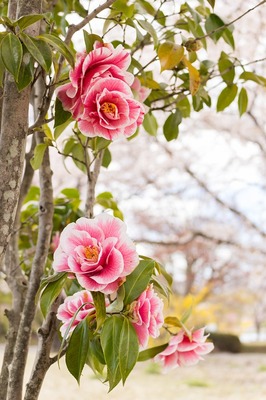Pretty pink, red, purple, yellow, white, small, large, double, single, specimen shrub, hedging plant…all these describe a particular plant that is and has been, flowering beautifully in our area over a long period.
This shrub is of course the spectacular camellia in all its varieties. Over the last 60 years or more there has been a lot of work done in improving this lovely shrub and what was once a fairly difficult and specialised plant to grow is now much simpler for the average gardener.
The varieties are such that they now tolerate a much wider range of soil types and climate conditions.
As a small child, I remember one very large specimen tree in a garden where I lived and it was a treat to see the white blossoms covering it, but they were to be looked at and admired but not touched as they very readily fell from the bush and turned brown from being touched.
Now there is a camellia for every position and purpose in every garden. They are now hardy and relatively easy to grow and will give many years of pleasure. The oldest known camellia is in a monastery garden in China, and believed to have been planted in 1347 but there are many around the world that are between one and 200 years old.
The camellia is native to an area of southern and eastern Asia ranging from the Himalayas to Japan and Indonesia. There is some controversy over the exact number of named species but it is believed to be somewhere between 100-300.
The varieties most grown in our area are the sasanqua and the japonica. The trivia for today is that in June 1999, the Alabama U.S.A. legislature, officially adopted the Camellia Japonica as their state flower.
While they are adaptable to a wide climate range from the cooler areas of Melbourne and the Blue Mountains west of Sydney right up to the humid areas of Queensland, the thing to remember is that not all varieties grow in all areas. What does well in cool areas will struggle in these northern regions and vice versa, so be sure to pick your shrub from a reputable source and seek advice so as not to be disappointed.
Some like shade while others require and thrive in full sun. Some do really well as a hedge while others like to stand alone and be the star of the show. A bit like people really when you think about it! A variety I had not heard of before is the reticulata and apparently they are the “show girls” of camellia varieties.
Japonicas generally prefer some shade and flower in winter. They come in all forms and colours and grow from one to four metres high depending on the situation and variety, love being pruned and their shiny green foliage is used widely in floristry as a “filler”.
Sasanquas generally start flowering in February and continue through June and July, have smaller leaves and flowers than japonicas but a similar colour range and are quite happy in full sun. Once again, depending on the variety, they will grow from one to four or five metres tall and also respond well to pruning.
They are the variety you will see used as a hedge and recently when I was in the Maleny area, I saw some really spectacular hedges. The flowers tend to only last on the bush for a couple of days then fall to the ground creating a lovely floral carpet. I know some people who don’t like this and see it as a mess to be dealt with. These same people generally don’t like jacarandas flowers or autumn leaves either.. I feel sorry for them! To me these things are some of the real joys of gardening.
There are many other species of camellia and one other that is worth mentioning for the trivia value is Sinensis as this is the “tea” camellia. All varieties of green and black tea came from this plant other than, of course, the various herbal teas that are available these days.
Then if you really want more, like Oliver Twist, there is an enormous range of hybrids available that have been developed form crossing sasanquas and japonicas and reticulatas to produce different colours, number of flowers, flower size, fragrance and cold tolerance.
Now to soil conditions. They prefer a good well drained slightly acidic soil and like to be kept moist but not wet. A good layer of mulch will help this but avoid using chook manure or mushroom compost as this will very likely prove too alkaline. Well-rotted cow or horse manure mixed into the soil is good but avoid using lime. When planting your shrub, to assure good drainage, mix in a barrow load of gravel as this will help prevent root rot from water logging.
Water well when new but once established more camellias are killed from over watering and over fertilising, causing fertiliser burn, than from neglect. They are remarkably dry-tolerant once established and even in summer when the leaves appear to wilt in the heat of the day, they generally revive as evening approaches. Once they are established, a good watering once a week should suffice.
Don’t forget to buy your tickets from Danny Lyons for the bus trip on 8 July to the Qld Garden Expo. It will be a most enjoyable day out for anyone interested in anything to do with gardening!







